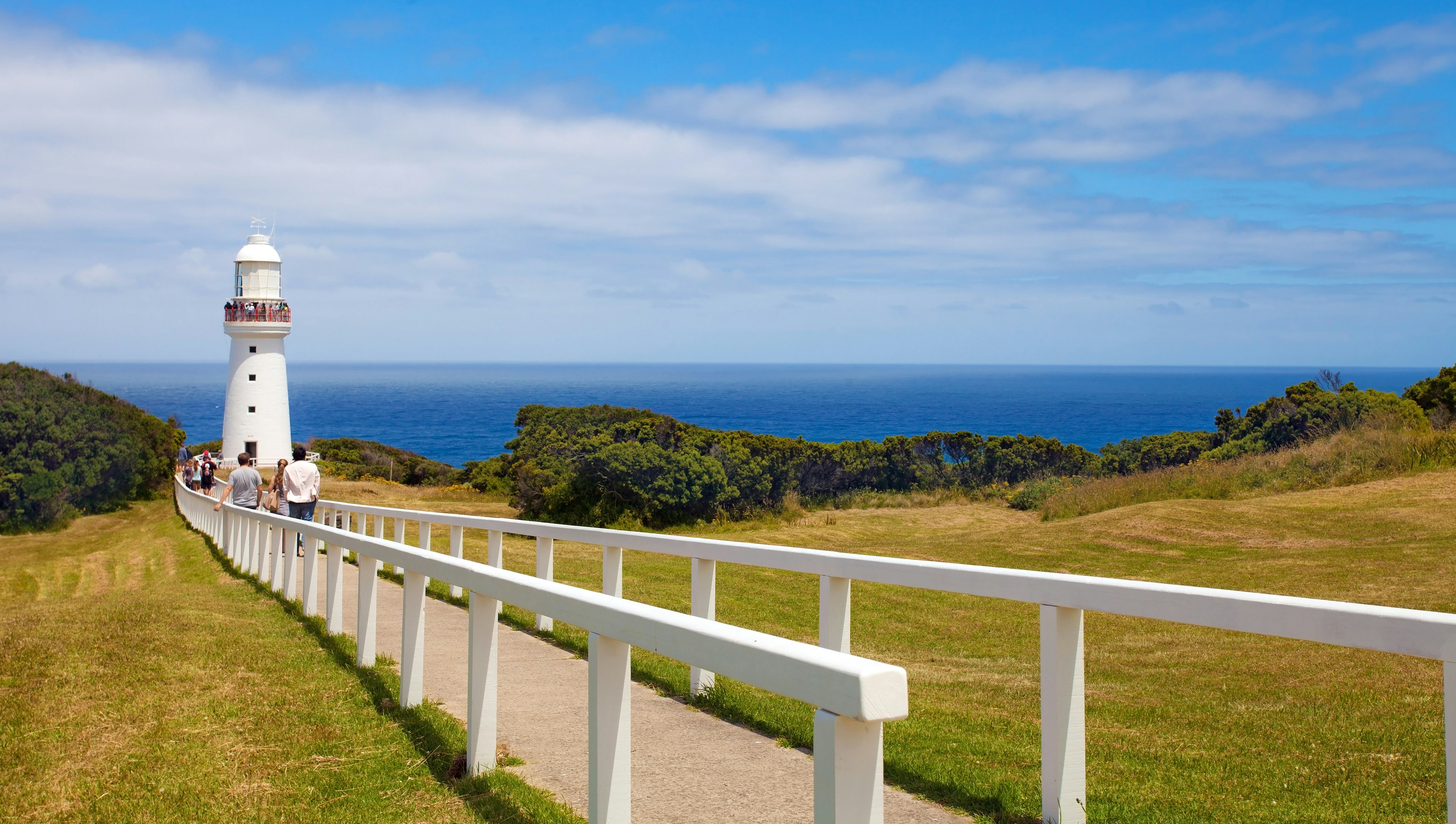

You've heard of the Great Ocean Road, but did you know you can also walk this stunning Australian coastline? © Sarah Reid / Lonely Planet
Cerulean waves crash into limestone cliffs and plump koalas doze in ghostly white gum trees on the wild southwestern coast of Victoria, a rugged natural wilderness within easy reach of Melbourne.
This windswept stretch of the Australian coastline is best known as the home of the Great Ocean Road. One of Australia’s most iconic road trips, the scenic 243 km (151 mile) coastal route weaves through a patchwork of national parks and kangaroo-dotted farmlands towards the surreal limestone stacks known as the Twelve Apostles.
However, that's not the only way to soak up the sublime views: the region is also home to the Great Ocean Walk (GOW), a 110km (68-mile) one-way hiking trail that links Apollo Bay to the Twelve Apostles.
Despite its close proximity to the Great Ocean Road in some sections, the GOW is a wonderfully wild walk that feels further removed from civilization (and traffic on the driving route) than it actually is. Hugging the coastline more closely than the Great Ocean Road, the GOW rewards hikers with more dramatic vistas and a deeper immersion into the region’s beauty.
The good news is that you don’t need to have camping gear or a full week set aside to experience it. While the GOW takes six to eight days in its entirety, it’s possible to tackle much shorter sections, making it accessible to those with limited time, fitness or mobility. With the help of a hire car and local shuttle services that cater to hikers, it’s even possible to get a GOW fix and be back in Melbourne in time for dinner.
Here’s our pick of the best day, and half-day, hikes along the Great Ocean Road from east to west.

1. Marengo to Shelly Beach
Best for an easy ramble
4.4km/2.7 miles, 2 hours, easy to moderate
This relatively gentle hike offers a great taste of the Great Ocean Walk for travelers staying in Apollo Bay, where the GOW officially begins. There are three beach walking sections on this trail ending at the Shelly Beach picnic area, tucked up in the coastal forest behind the beach, making it essential to embark at low tide. If conditions allow, there are several additional spots you can opt to walk along the sand and rock platforms instead of sticking to the main trail tracing low cliffs. Swimming is possible in calm conditions.
How to do it: If you don’t have time or energy to do the walk both ways, leave your car at Shelly Beach picnic area and arrange for a shuttle to Marengo (3km/1.9 miles from Apollo Bay), where you’ll begin your walk. If you don’t have a vehicle, shuttles can be arranged at either end.

2. Blanket Bay to Cape Otway
Best for wild swims and history
11km/6.8 miles, 3-4 hours, moderate
This writer’s favorite section of the GOW takes you deep (or at least it feels like it) into the lush coastal forest of Great Otway National Park before popping out onto the beach at pretty Parker Inlet – a perfect spot for a swim. After crossing the inlet and rounding Point Franklin, the trail hugs the cliffs, offering stirring Southern Ocean views en route to Cape Otway, with another swimming option at Crayfish Bay.
Aim to arrive at Cape Otway well before 4pm to explore the Lightstation precinct (AU$10/adult), where you can learn the stories of the Cape and visit heritage buildings including the striking 1848 lighthouse once known to seafarers as the “Beacon of Hope".
How to do it: If you don’t have a car (or two) to leave at either end of this trail (Blanket Bay is 36km/22 miles from Apollo Bay), prebook a shuttle drop-off/pick-up.
Hire a car and check out the best road trips from Melbourne
3. Cape Otway to Aire River
Best for chasing waterfalls
9.8km/6 miles, 3-4 hours, moderate to difficult
The power of the Southern Ocean comes into dramatic focus when this trail opens up on the eroded cliff tops after about 2km (1.2 miles). If the sea is calm and the tide is low, you can opt to drop down to sea level and walk along the soft (read: challenging) sand of Station Beach for 2km (1.2 miles) before rejoining the main trail. There’s also an optional 2km (1.2-mile) return detour to Rainbow Falls, where colorful algae blooms along the vertical path of a spring-fed waterfall. Don’t miss the 19th-century Lightstation cemetery at the beginning of the trail.
How to do it: Prebook a shuttle drop-off/pick-up, or leave a car at either end of the trail. Cape Otway is 27km/16.8 miles from Apollo Bay.

4. Castle Cove to Johanna Beach
Best for koala spotting
6.3km/4 miles, 2 hours, moderate
It’s possible to spot koalas and other native wildlife including wallabies, kangaroos and echidnas along the entire GOW, but sightings of Australia’s most iconic marsupial are particularly common on this leg, which begins with a superb lookout towards the cliffs of Rotten Point. The trail winds along cliffs and through prime koala habitat (don’t forget to look up!) before dropping down onto the golden sands of Johanna Beach for the final 2km (1.2 miles), which can feel like double that length in the soft sand. Powerful waves and strong currents make swimming risky – the safest spot is generally in front of the vehicle-accessible Johanna Beach GOW campground.
How to do it: If you don’t have a car (or two) to leave at either end of this trail (Castle Cove is 33km/20.5 miles from Apollo Bay), prebook a shuttle drop-off/pick-up.
Save this guide to the best national parks in Australia
5. Wreck Beach
Best for maritime relics
2km/1.25 miles, one hour, moderate
Nearly 700 vessels are thought to be submerged along the 130km (81 miles) stretch of coastline between Cape Otway and Port Fairy, also known as the Shipwreck Coast. This short walk (low tide only) takes you down 350 steps to the rocky beach where the rusting anchors of the Marie Gabrielle (wrecked in 1869) and the Fiji (wrecked in 1891) are haunting reminders of how treacherous the Southern Ocean can be. If conditions permit, you can make this walk a circuit by scrambling over the rocks past the Fiji anchor and connecting with the GOW trail for the return walk to the car park. Leave your swimwear behind – this rocky beach isn’t ideal for a dip.
How to do it: Drive to Wreck Beach car park or book a return shuttle to this remote area, 38km (23.6 miles) from Port Campbell, the closest town to the end of the GOW.

6. Princetown to Twelve Apostles
Best for admiring the Twelve Apostles
7km/4.3 miles, 2 hours, easy to moderate
It won’t be long before you get your first glimpse of the Twelve Apostles on this gently undulating, exposed clifftop trail. Set off as early as possible to beat the heat, and the day-tripper crowds from Melbourne. While only seven of these golden limestone pillars can be seen rising from the coastal shallows today, it’s an awesome sight that gets better as you hike closer. A viewpoint just east of Gibson Steps makes for a fine place to pause for a snack. Then take a short detour down the steps to savor the sea-level views before continuing onto the main Twelve Apostles viewing platforms (including the striking new Saddle Lookout) at the end of this trail – the terminus of the GOW.
How to do it: Base yourself in Port Campbell and drive or book a shuttle to the trailhead near Princetown (17km/10.6 miles from Port Campbell). It’s 11km (6.8 miles) to Port Campbell from the Twelve Apostles Visitor Centre.
Looking for something under-the-radar to see in Australia? Read on for some local favourites
7. Loch Ard Gorge Walks
Best for epic and accessible views
5.5km/3.4 miles, 2 hours, easy
It’s not technically part of the GOW (which officially ends 3km/1.9 miles east at the Twelve Apostles), but if time is tight or you have limited mobility, this trio of interconnecting, wheelchair-accessible trails in Port Campbell National Park takes you to some of coastal Victoria’s most memorable lookouts. The Geology Walk (900m/0.6 miles return) leads to the Razorback, a jagged hulk of limestone rivaling the Twelve Apostles. The Shipwreck Walk (1.4km/0.8 miles return) takes you along the rim of the main gorge, where the only two survivors of the Loch Ard shipwreck in 1878 dragged themselves onto its beach (not currently accessible); the cemetery where some of their shipmates were buried; and a lookout to Mutton Bird Island, where the Loch Ard met its fate. Hear the roar of the water surging into Thunder Cave on the Edge Walk (3.2km/2 miles return), which takes you further along the cliffs.
How to do it: Loch Ard Gorge car park is 8km (5 miles) from Port Campbell; self-drive or get a taxi.
Tips for day hiking on the Great Ocean Walk
The V/Line bus runs from Melbourne to Apollo Bay daily, but local public transport is infrequent and taxis are in short supply; book shuttles in advance.
If you’re hiring a car, ensure you can take it on unsealed roads, although a 4WD is not essential.
All trails with unavoidable beach sections should be undertaken at low tide.
Expect patchy mobile (cell) service on all trails.
The GOW is remote – check the weather forecast before you go, but be prepared for all conditions.
Bring plenty of drinking water and snacks; the only shop/cafe on the GOW is at the Cape Otway Lightstation.
All one-way trails in this article can be completed as out-and-back hikes in a day.
All three local snake species are venomous. Give these shy creatures space to move off on their own if you encounter one basking on the trail.
The writer traveled as a guest of Adventures in Good Company, which includes day hikes on the Great Ocean Walk, operated by AusWalk, on its Adventures Down Under tour. Lonely Planet writers do not accept freebies for positive coverage.
Explore related stories










